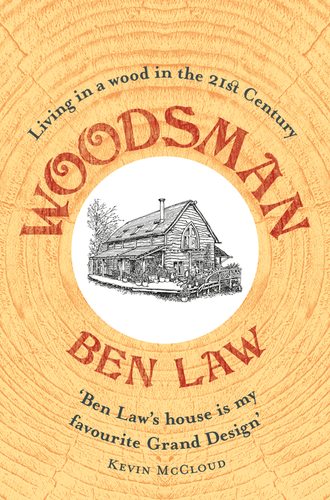
Полная версия
Woodsman
Storing water has to be one of the most practical ways we can improve and help our local environment. I am astonished how much rainwater it is possible to catch, even off a modest-sized roof. When I lived for a couple of years in a 30- by 10-foot caravan, I collected the rainwater off the roof in four 50-gallon rainwater butts that were all linked together. The butts were raised up and I drew the water off the end butt through the caravan wall and out through a tap into the sink. These butts supplied all the water I needed for washing up and to run a shower throughout the whole year. Even when they began to run low in summer, it took just one big thunderstorm and they were all filled up again.
If you measure the area of the roof of your house and multiply it by the average local rainfall for your area (available from your local meteorological office) you will be able to estimate the average volume of rainwater you could be collecting from your roof. I have two buried 10,000-litre tanks that irrigate all the vegetable gardens and that are often overflowing. You will most likely be surprised to find how much water you could be harvesting from your roof.
It is easy to become complacent in England about water, as often we have lots of it. But droughts are not uncommon, and as our climate seems unpredictable and unsettled it would make sense for every home to be maximising their water-storage options. It should be compulsory for every new home to have water storage as part of the design.
* * *
My first year at Prickly Nut Wood was one of observation. Of course, I cut wood, built myself a basic shelter and drew water from an old catchment well within the woods, but beyond that I came to observe.
It was the late 1980s and I had been travelling in South America, predominantly searching for solutions to the leaflets that kept appearing through the letterbox telling me an area of the Amazon rainforest the size of Belgium was being destroyed every day. Such a scale of destruction of rainforest was hard to contemplate. I felt inadequate in Sussex discussing the fate of our planet amongst friends and wanted to do something to help. The irony, of course, being that my travels made it clear to me that I needed to focus my work locally. And so I ended up at Prickly Nut Wood, just a couple of miles from the letterbox where the leaflets had arrived, the ones that sent me, young and headstrong, to the other side of the world. The story of The Alchemist by Paulo Coelho describes a similar realisation.
What my travels abroad showed me was a pattern. The pattern of the forest dweller. In the Amazon rainforest, and later in Papua New Guinea, I spent time with people who were children of generations of families who had dwelled within the forest. I met people to whom the forest was an extended map of provisions. They knew where to find medicinal plants to treat their ailments, they knew where migratory species would arrive and when, they lined their pathways with fruit-producing trees to eat from and harvest whilst on their journeys to visit friends or neighbours, and they built their houses from timber growing around them. These forests were rich in biodiversity, and the knowledge and lore of the forest had been passed on by its human inhabitants. Children grew up learning the different uses of plants, and where to find and harvest fruit-growing trees without realising they had learnt it. Education came through being brought up in one place, knowing that landscape, and being fully integrated into a way of life that was simple, although, of course, this life was not without its hardships. This tradition of the forest dweller being a natural form of woodland management seemed to be missing from the way forests were managed in England.
At Prickly Nut Wood, I wanted to live as a forest dweller, but I had not grown up as one and had no one to show me the lore of the land. I had to learn it through experience and observation, and I also had to transfer the pattern observed in diverse tropical rainforests to the woodlands of the south of England.
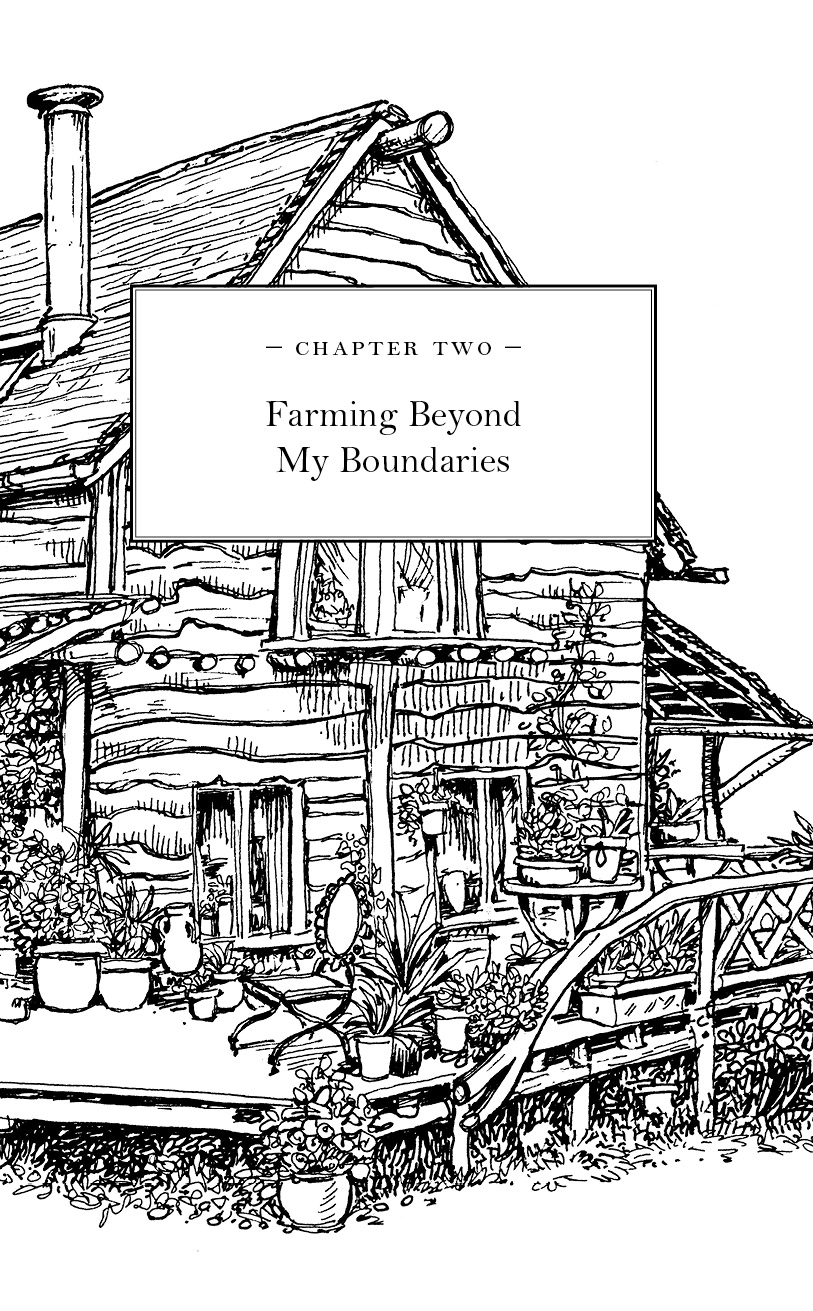
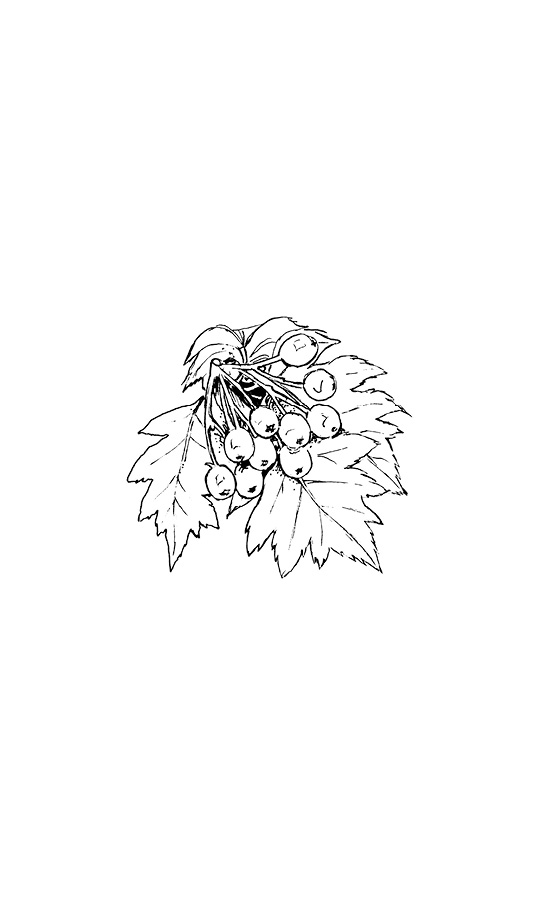
During my year of observation, I expanded my knowledge of the locality by regularly walking the generous collection of footpaths that weave through the parish. In doing so, I began to build up a map of surrounding foraging sites to which I could seasonally return over the coming years.
If I strike east from Prickly Nut Wood, I pass through an ancient wooded common, which has not been grazed for many years. Large, outstretched, pollarded oaks cast dappled shade over what were once pastures, now patches of wood sedge and bracken. Dark pools surrounded by thickets of blackthorn make this enchanted woodland a fine source of sloes. Whether for wine or gin, these ‘dry your mouth’ plums are worth collecting as the flavour when fermented or steeped in a spirit brings laughter to most who partake in their pleasure. The blackthorn itself can be the most impenetrable of trees, with sharp thorns that tend to poison the skin when pricked. Many a time have I noticed what seemed a scratch from blackthorn inflame in to a septic wound. This tree deserves respect. I remember reading how a 14-foot-wide hedge of blackthorn was once planted around Farnham Castle for protection. In the days when a septic wound could be life-threatening, the use of blackthorn would have led any potential invaders to have second thoughts.
The common is bisected by the road and it is here my life nearly ended some years ago in a car crash. I mention this as I ended up in a hedge and a spike of blackthorn pierced my eye. In protecting itself my eye formed a cataract and I had to have the lens replaced, so I am fortunate still to have good vision. I returned to the site a few months after the accident and cut myself a blackthorn stick from the broken bush near where I’d had my collision. It has made a good walking stick and is a good reminder to me of the fragility of all life. Blackthorn makes excellent walking sticks but it is a challenge to cut – a good pair of gauntlets is recommended. As part of my winter work involves laying hedges, I have some very heavy-duty leather hedging gloves that enable me to grasp the stem of blackthorn others might shy away from.
Hedge laying has begun to see a renaissance over the past 20 years. Stewardship grants have led farmers and landowners to consider the wisdom of starting their tractors and spending the day ‘flail cutting’ the top and sides of the hedge, and using much diesel to destroy the biomass that has grown within the hedgerow. Laying a hedge involves ‘pleaching’ (partially cutting through) the upright stem, in order to bend the stem over and lay it at an angle so that it forms a woven barrier and all knits together. The top (in the style of the hedge laying I carry out) is woven with hazel binders around upright posts of sweet chestnut about 1 foot apart. The resulting hedge not only looks attractive and uniform but forms a strong, long-lasting and stock-proof barrier, removing the need to use steel fencing altogether. It can then be left to grow on for about fifteen years and the next time it is laid, there will be a firewood crop yielded from the hedge row as well as some interesting elbow shaped pieces of timber formed from the re-growth from the pleached stems. These pieces can make fine walking sticks or, as I have found, can be used to make traditional knees in boat building. My first rowing boat contains ash and chestnut knees formed from material sourced whilst hedge laying. Laying a hedge also creates the perfect nest-building habitat. The angled stems, woven together and then supported by stakes and upright re-growth, make the ideal support for nest building. So a well-laid hedge will increase biodiversity, work as a stock fence, provide material for walking sticks and other projects, provide firewood, remove the need to use steel fencing, and can also provide a good site for foraging if the species used are well chosen. Surely this productive and diverse hedgerow, which can be managed with hand tools, must be a more sustainable alternative to repeated cutting with a tractor and flail cutter.
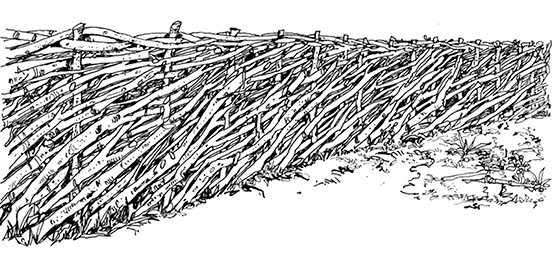
28 December
I was greeted this morning by the perfect winter day. A good, crisp frost meant I needed a couple of layers under my Swandri, but after an hour of work the sun was warming me and I shed a layer. I started on the hedgerow down the northern side of Meera’s wood. This hedge will wind for about a mile and I look forward to the day when I can stand back and see the hedge in its full glory, matured and bursting with wildlife and wild food. It’s hard to find words to encompass the sense of satisfaction and fulfilment I get from planting trees and hedgerows. Such work should be part of everyone’s life. A year of ‘national service’ to improve our environment would be a good statement for an evolving society.
I chose hawthorn and blackthorn as the main species, as they lay well and form an impenetrable boundary. They also produce sloes and haws from which to make wines or jellies. In addition, I planted hazel to provide nuts and materials for craft use; spindle to add diversity and create sticks for artists’ charcoal; field maple to have its sap tapped for wine; holly for berries for the Christmas market; Guelder rose for its medicinal cramp bark; dog rose and rugosa rose for the hips for rose hip syrup; cherries for fruit (for the birds); a few oak standards to grow and mature from within the hedge to form ancient trees for future generations, increasing the hedge’s biodiversity; and crab apple for pollination and the making of verjuice.
Verjuice
Collect ripe crab apples and leave them in a plastic bag to sweat. After a few days press out the juice and then bottle it, leaving cotton wool in the top as it will ferment because of the natural yeasts. It will be ready in about a month and makes a traditional substitute for lemon juice. It is particularly good in salad dressings and stir fries.
After eight good years of growth, I laid the hedge and now sheep graze in the fields without any fencing, the hedge successfully keeping them within the field. Planting hedgerows and laying hedges that I can return to as I walk the parish, harvesting wild food and produce that I know is there, form part of my farming of the surrounding countryside.
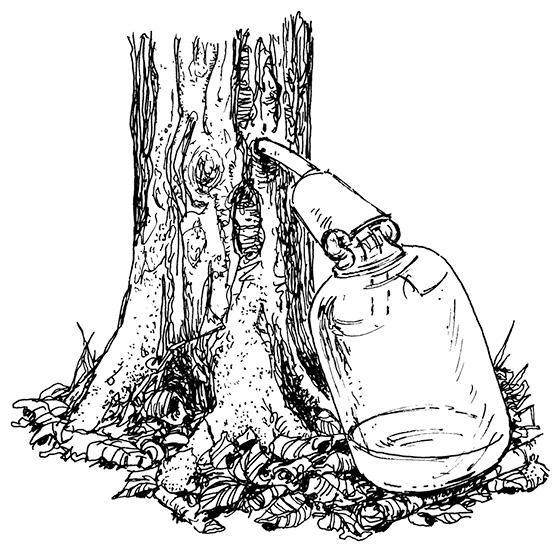
Bordering the common is one of the orchards I have planted over the past 20 years. Now the trees are producing well and the orchard provides cider apples for the village pressing. I planted ‘Harry Masters Jersey’, ‘Crimson King’, ‘Yarlington Mill’ and ‘Kingston Black’, and they all make a fine cider, whether mixed or fermented out to single-variety ciders. The trees are pruned as standards, which allows sheep to graze beneath, a traditional silvi-pastoral system that I expect we will see more of in the coming years. Lodsworth has always been a cider-making area and throughout the village well-established old trees can be seen, now enclosed in gardens from parts of the old orchards of days gone by. I remember old Ted Holmes telling me before he died of the mobile press that used to turn up outside the Hollist Arms pub, and the excitement he experienced as a young lad on apple-pressing day.
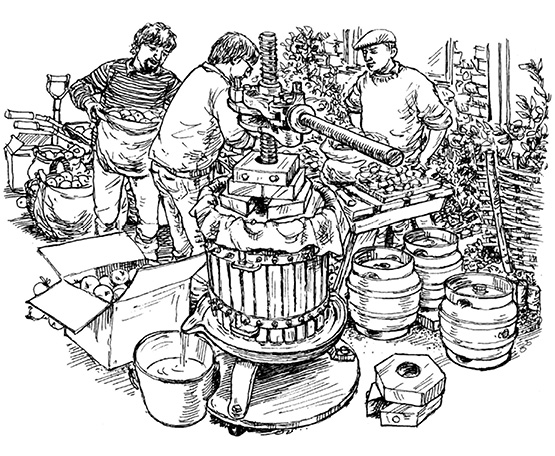
I remember the tasting on the first night we revived the tradition. It was election night when we brought the cider to the bar of the Hollist Arms. Nick Kennard was the landlord then, and with his wife Sally they ran the house well (although the beer was sometimes interesting!). The cider was strong that year and I noticed after a couple of hours that tongues were loosening, quite literally in the case of a respectable couple who worked for the European Union. The evening evolved into a party and the next morning Lodsworth was one place in England where many of the residents had no idea that Tony Blair had been elected for his first term as prime minister. Since that time our cider making has improved and the quality of the drink is more refined. Many a good winter’s evening has been spent racking and blending to ensure the best quality is available for village functions.
* * *
Ted Holmes was a forester/coppice worker who worked mainly on the adjacent Cowdray estate. Ted would nod at me but rarely spoke – I was a different type of coppice worker, I lived up in the woods. One evening in the Hollist Arms, I bought Ted a beer or two, and he told me the story of his life as a boy in the village and the work he would do. His descriptions of village life painted a vivid picture for me – I could see his early-morning work in the bakery, then, moving on to the wheelwrights, how he would throw water over the metal tyre to cool it before it burned the wood of the wheel. Traditionally the metal tyre would be heated so that it expanded, and when it was glowing red it would be fitted over the wooden wheel rim and hammered into place. Once in place it was doused with water to stop burning the wood and the cooling process would shrink the metal tyre tight on to the wooden wheel, compressing it all together. A wheelwright was an important profession and with three blacksmiths all working in the village it was a thriving small community.
Ted talked to me about the cider, and in particular the plum and gage orchards that grew to the north of the village and the abundance of cob nuts along the eastern edge. Fruit picking formed part of his day as a boy as it does mine now. I’ve planted plums and gages in similar areas of the parish to where Ted mentioned they grew, and so far the trees have grown well and crops have been good. There is a lot of knowledge of our localities locked up in the memories of the older generations that will be useful in the future, when we are likely to need to become more locally based and self-supporting, and need to be able to turn our hands to a variety of different skills.
The cob nut orchard that ran along the eastern edge of the village has been lost amongst the many houses and gardens that have been built. Some gardens have one or two established nut trees remaining, but in a couple of places the orchard has remained intact and I’ve been fortunate to spend time restoring these areas.
When I first cut the derelict orchard, or ‘platt’, as a cob nut orchard is often called, it was a matter of cutting back thick, overgrown stems and reshaping the cob nut trees to form a goblet shape. The re-growth is then ‘brutted’ (snapped so that the branch is stressed and left to hang, still well attached to the mother tree by the fibres that are so strong in hazel wood). These goblet-shaped trees then produce an abundance of nuts. Commercially, most cob nut orchards are grown well away from woodland, in areas where squirrels are less likely to risk crossing open pasture to reach the delicious nuts dangling from the ‘brutted’ trees. I have now pruned the cob nut orchard on a couple of occasions and the trees are producing well once again.
Restoration of old fruit trees has kept me busy over many years and, by working in many individual gardens on the old trees, I’ve been able to see the patterns of the orchards that were once so much a part of our village landscape. Identifying old varieties is not easy; some are clearly distinctive but as many varieties have a similar ‘parent’ apple, identification can become difficult. One or two of the local Sussex varieties are easier to identify. ‘Sussex Forge’, an old cottagers’ apple, dates from 1923. It is a small, yellow apple, streaked red with a red flush and is a good dual-purpose apple, as it cooks well and is of good flavour eaten fresh. The more I have worked with apples, the more respect and fascination I have for these wonderful fruits and the regional history that so many varieties bring with them. Our wild crab apple, Malus sylvestris, can often be found amongst ancient woodlands and was no doubt an important food and fermentation source for generations past, as were so-called ‘wilding apples’ (grown from discarded apples or cores) and cultivated varieties, the earliest of which recorded is the ‘Pearmain’. This was the first named variety recorded and is noted on a deed of 1204. Since that time we have bred and crossbred apples to have a vast variety of cookers, eaters, dual-purpose, sliders, girlies and keepers – in fact the National Apple Collection in Brogdale, Kent, lists over one thousand varieties.
Planting new orchards is a favourite activity of mine. One must select a succession of varieties that will produce over a period of time, yet be part of the right overlapping pollination groups to ensure bees and other insects carry out their gift of duty. Some apples are tetraploids as opposed to diploids, so they need two other varieties to pollinate them. ‘Blenheim Orange’ and ‘Bramley’ seedlings are two well-known tetraploids. Most apples are then grafted onto a root stock, which dictates the height and expected lifespan of each tree. Most apple root stocks now used are root stocks that were developed at East Malling Research Station and hence have the name M from Malling, followed by a number. M25, for example, forms a large tree, whereas M27 forms a tiny tree. Which all makes it quite difficult when I’m asked that common question: ‘I’ve got an old apple tree. Can you tell me what variety it is?’
Most small apple trees in gardens are on M26 rootstocks. These provide a relatively short-lived tree that will grow to about 10 feet (3m) in height and produce fruit at a young age. At Prickly Nut Wood I have a few apples on M26 rootstocks near the house and around the vegetable garden. Further afield I grow apples on the medium-sized MM106, and my largest apple trees are grafted on to M25. There are similar rootstocks for pears and plums. Most of my pears are on Quince A rootstock, which produces a large tree, with a few on Quince C, which produces a smaller, productive tree. Most of my plums are on the semi-vigorous rootstock St Julien, with a few near the house on the dwarfing rootstock Pixy, and a few larger plums on the vigorous Myrobalan B rootstock. Choosing the appropriate rootstock for the right situation – and visualising the heights and varieties – make planning and planting an orchard one of my favourite seasonal countryside activities. I am often asked for advice on what to do with one field or another by a local landowner. In most cases I advise planting orchards. By planting standard trees (or planting maiden trees and pruning them to become standards) on large, vigorous root stocks well spaced out across the field, the orchard will establish well, allowing for grazing by sheep or geese below. These orchards are a beautiful landscape feature in their own right, brightening the fields every spring with blossom, the promise of fruit to come. The planting and establishment of orchards throughout the countryside will leave an important food legacy for the next generation.
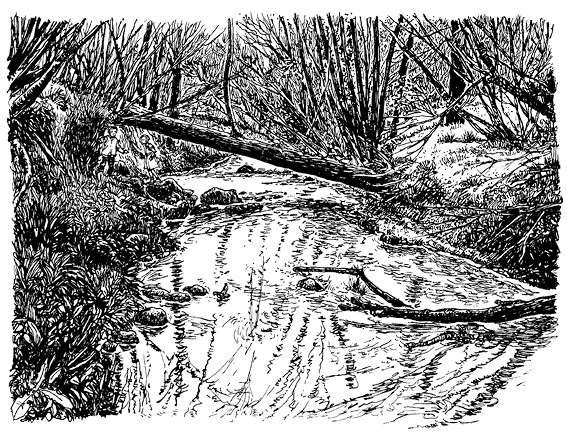
Restoring old fruit trees and orchards, as well as planting new ones, have helped me to cultivate many plants in the surrounding landscape, although I can’t exactly claim that I am farming them.
As I turn and head south, with the sensual curves of the South Downs silhouetted in the distance, I join the small, winding waterway – the River Lod. Rising north-east of Lynchmere, and picking up many streams along its journey, it skirts the village of Lodsworth before joining the River Rother at Lod’s Bridge, which in turn joins the Arun and continues on out to sea at Littlehampton. As the Lod winds south through the parish it makes its way through mixed coppice woodland – hazel, ash, field maple and willow – below which can be found abundant bluebells, yellow archangel, early purple-flowering orchid and wood anemone in late spring. Preceding this flush of colour, the wood is carpeted with the dense mass of foliage of wild garlic. A walk this way in spring and you will be aware of the wild garlic before you see it. Its poignant aroma fills the air well in advance of its physical presence. I harvest the wild garlic for stir-fries and salads, a cheese sandwich for lunch is greatly enhanced by a few leaves, and it makes an excellent pesto. I have supplied pubs and restaurants with the leaves over the years, and in my early days at Prickly Nut Wood I would often trade beer for wild garlic at the local hostelries.
The Lod is a healthy, clean river and salmon trout spawn as far up as the mill pond at Lurgashall. Brown trout are common, as are bream, roach, chub and pike. As a small river it is not often fished, with the nearby River Rother being more popular with anglers. One part of the river that seems never short of water is near the bridge at Lickfold. The road regularly floods here, and after heavy rains it can be hard to make out what is bridge and what is river. There have been a number of civil engineering works over the past couple of years to try to improve the regular flooding, but so far I have seen little evidence that they have made much difference. I am astonished at how often we seem to throw money at trying to find a solution to a problem that is part of nature. Water has clearly always flooded at Lickfold, which is a low point for water collection and is well fed from surrounding fields. It is not a major route, is only impassable for a few days a year and there are alternative routes, so it would seem to make sense to leave the river to flood when it wishes at Lickfold Bridge and focus our civil engineering energies on more useful projects.




